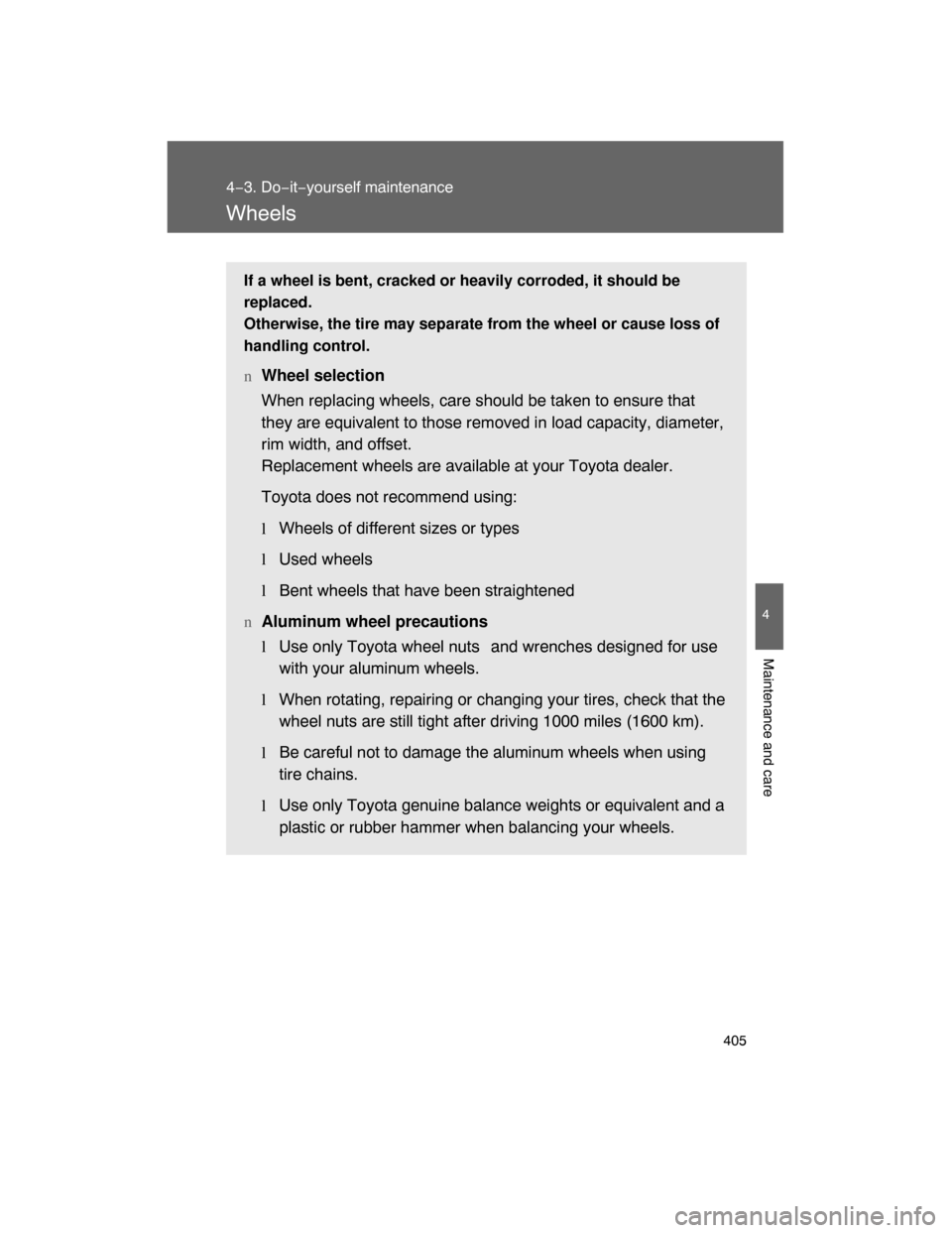Page 228 of 531
230 2−5. Driving information
Trailer tongue load
lA recommended tongue load varies in accordance with the types
of trailers or towing as described below.
lIn order to ensure the recommended values shown below, the
trailer must be loaded by referring to the following instructions.
The trailer cargo load should be distributed so that the tongue load
is 9 to 11 %.
(Tongue load / Gross trailer weight 100 = 9 to 11 %)
If the gross trailer weight is over 5000 lb. (2268 kg), it is necessary
to use a sway control device with sufficient capacity.
The gross trailer weight and tongue l oad can be measured with plat−
form scales found at a highway we
ighing station, building supply
company, trucking company, junk yard, etc.
Gross trailer weight
Tongue load
Page 235 of 531

237
2−5. Driving information
2
When driving
CAUTION
nTrailer towing precautions
lFollow all the instructions described in this section. Failure to do so could
cause an accident resulting in death or serious injury.
lExceeding the towing capacity, GVWR, GCWR and GAWR can cause an
accident resulting in death or serious personal injuries.
nTo avoid accident or injury
lDo not exceed 45 mph (72 km/h) or the posted towing speed limit, which−
ever is lower. As instability (swaying) of the towing vehicle−trailer combina−
tion increases as speed increases, exceeding 45 mph (72 km/h) may
cause loss of control.
lSlow down and downshift before descending steep or long downhill
grades. Do not make sudden downshifts.
lAvoid holding the brake pedal down too long or applying the brakes too
frequently. This could cause the brakes to overheat and result in reduced
braking efficiency.
lDo not exceed the trailer hitch assembly weight, gross vehicle weight,
gross axle weight and trailer tongue load capacities.
lNever load more weight in the back than in the front of the trailer. About
60% of the load should be in the front half of the trailer, and the remaining
40% in the rear.
l
Do not use cruise control when you are towing.
Page 391 of 531

396 4−3. Do−it−yourself maintenance
nMaximum load of tire
Check that the maximum load of the re
placed tire is greater than 1/2 of
the Gross Axle Weight Ratings (GAWR) of either the front axle or the
rear axle, whichever is greater.
As for the maximum load of the tire, see the load limit at maximum cold
tire inflation pressure mentioned on the sidewall of the tire, and as for the
Gross Axle Weight Ratings (GAWR)
, see the Certification Label. ( P.
401, 507).
nTire types
1 Summer tires
Summer tires are high−speed performance tires best suited to highway
driving under dry conditions. Sinc
e summer tires do not have the same
traction performance as snow tire s, summer tires are inadequate for
driving on snow−covered or icy roads. For driving on snow−covered
roads or icy roads, the use of
snow tires is recommended. When
installing snow tires, be sure to replace all four tires.
2 All season tires
All season tires are designed to prov ide better traction in snow and to
be adequate for driving in most winter conditions, as well as for use
year round. All season tires, however, do not have adequate traction
performance compared with snow tires in heavy or loose snow. Also,
all season tires fall short in acceleration and handling performance
compared with summer tires in highway driving.
3Snow tires
For driving on snow−covered roads or icy roads, we recommend using
snow tires. If you need snow tires,
select tires of the same size, con−
struction and load capacity as the or iginally installed tires. Since your
vehicle has radial tires as original equipment, make sure your snow
tires also have radial construction. Do not install studded tires without
first checking local regulations for possible restriction. Snow tires
should be installed on all wheels. (
P. 222)
Page 396 of 531
401
4−3. Do−it−yourself maintenance
4
Maintenance and care
Tire inflation pressure
nTire inflation pressure
The recommended cold tire inflation pressure and tire size is dis−
played on the tire and loading information label. (
P. 502)
TIRE SIZECOLD TIRE PRESSUREPXXX/XXRXX
PXXX/XXRXXXXXkPa,XXPSI
XXXkPa,XXPSI
XXXkPa,XXPSI
PXXX/XXRXXPXXX/XXRXX
PXXX/XXRXX
PXXX/XXRXXXXXkPa,XXPSI
FRONT
REAR
SPAREPNEUSDIMENSIONPRESSION
GONFLAGE A FROIDDEXXXkPa,XXPSI
XXXkPa,XXPSI AVA N TARRIERESECOURS
TIRE
SEE MANUAL
ADDITIONAL INFORMATIONFOR OWNER’S
AND LOADINGSEATINGTheand cargo should never exceed XXX XXXkg lbs.orcombined weight occupantsofCAPACITY TOTAL
FRONT
POUR
VOIR
LE DUMANUEL PROPRIETAIREDEPLUS AMPLES INFORMATIONS,
REARINFORMATIONINFORMATION
NOMBRE
Le
doit jamais etre a kg lb.ouXXX XXXsuperieur poids totaldes et du nechargementoccupantsDE PLACES ASSISESTOTAL X
AVA N T XARRIEREXSUR LES ET LEPNEUSCHARGEMENTXXX
ITY43C072
Page 398 of 531

403
4−3. Do−it−yourself maintenance
4
Maintenance and care
nEffects of incorrect tire inflation pressure
Driving with incorrect ti
re inflation pressure may result in the following:
lReduced fuel efficiency
lReduced driving comfort and tire life
lReduced safety
lDamage to the drive train
If a tire needs frequent re
filling, have it checked by your Toyota dealer.
nInstructions for checking tire inflation pressure
When checking tire inflation pressure, observe the following:
lCheck only when the tires are cold.
If your vehicle has been parked for at least 3 hours and has not been
driven for more than 1 mile or
1.5 km, you will get an accurate cold
tire inflation pressure reading.
lAlways use a tire pressure gauge.
The appearance of the tire can be mi
sleading. In addition, tire infla−
tion pressures that are even just a few pounds off can degrade ride
and handling.
lDo not bleed or reduce tire inflation pressure after driving. It is normal
for the tire inflation pressure to be higher after driving.
lNever exceed the vehicle capacity weight.
Passengers and luggage weight should be placed so that the vehicle
is balanced.
Page 400 of 531

405
4−3. Do−it−yourself maintenance
4
Maintenance and care
Wheels
If a wheel is bent, cracked or heavily corroded, it should be
replaced.
Otherwise, the tire may separate from the wheel or cause loss of
handling control.
nWheel selection
When replacing wheels, care should be taken to ensure that
they are equivalent to those removed in load capacity, diameter,
rim width, and offset.
Replacement wheels are available at your Toyota dealer.
Toyota does not recommend using:
lWheels of different sizes or types
lUsed wheels
l
Bent wheels that have been straightened
n
Aluminum wheel precautions
l
Use only Toyota wheel nuts and wrenches designed for use
with your aluminum wheels.
l
When rotating, repairing or changing your tires, check that the
wheel nuts are still tight after driving 1000 miles (1600 km).
lBe careful not to damage the aluminum wheels when using
tire chains.
lUse only Toyota genuine balance weights or equivalent and a
plastic or rubber hammer when balancing your wheels.
Page 487 of 531
494
6−1. Specifications
Maintenance data (fuel, oil level, etc.)
Dimensions and weight
*: Unladen vehicle
Overall length194.9 in. (4950 mm)
Overall width
77.6 in. (1970 mm)
Overall height
*74.0 in. (1880 mm)
Wheelbase
112.2 in. (2850 mm)
TreadFront64.6 in. (1640 mm)
Rear
64.4 in. (1635 mm)
Vehicle capacity weight
(Occupants + luggage)
1235 lb. (560 kg)
Towing capacity
(trailer weight + cargo weight)
8500 lb. (3856 kg)
Page 489 of 531
496 6−1. Specifications
Engine
Fuel
Model3UR−FE
Ty p e
8−cylinder V type, 4−cycle, gasoline
Bore and stroke 3.70 4.02 in. (94.0
102.0 mm)
Displacement 345.6 cu.in. (5663 cm
3)
Valve clearance
(engine cold)
Automatic adjustment
Drive belt tension
Automatic adjustment
Fuel type
Unleaded gasoline only
Octane rating
87 (Research octane number 91) or higher
Fuel tank capacity
24.6 gal. (93 L, 20.5 lmp.gal)